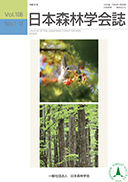
- |<
- <
- 1
- >
- >|
-
Hideki Ogawa, Atsushi Kumata, Naohiko Saitou, Satoshi Sakurai2024Volume 106Issue 1 Pages 1-6
Published: January 31, 2024
Released on J-STAGE: March 01, 2024
JOURNAL OPEN ACCESSThe 137Cs contamination of the ground part of Quercus serrata, used as mushroom logs, was investigated, 10 years after coppicing in February 2011 just before the Fukushima nuclear accident. In May 2021, nine sprouting coppiced trees were felled from the three stumps in a deciduous broad-leaved forest in Fukushima Prefecture. Stem, branch, and leaf samples were collected, and the 137Cs concentrations in each parts and the 137Cs stock in the stems and the thicker branches were measured. As a result, the concentration of 137Cs in the branch tips and leaves was significantly higher than compared to the thicker branches and the trunk, and there was a significant variation in concentration. The differences in 137Cs concentration between the thicker branches and the trunk and was small. It was suggested that there was a relatively stable distribution of 137Cs concentration in the vertical direction in the coppiced trees, except for the leaves and the branch tips. Moreover, the concentration of the stem showed a positive correlation with the leaves and the branches classified by the diameter, especially in the thicker branches. Furthermore, because collecting thicker branches is easier and their concentration variability is lower, compared to leaves or branch tips, it was more suitable to use thicker branches for estimating trunk concentrations for use of mushroom logs.
View full abstractDownload PDF (7743K)
-
Keita Endoh, Yuichiro Oribe, Tomohiro Kitayama, Souma Murata, Yoshiko ...2024Volume 106Issue 1 Pages 7-12
Published: January 31, 2024
Released on J-STAGE: March 01, 2024
JOURNAL OPEN ACCESS
Supplementary materialMorus boninensis is a critically endangered tree endemic to Japan's Ogasawara Islands. As part of ongoing ex situ conservation efforts, we have been raising M. boninensis seedlings in vitro to supplement wild populations on the Ogasawara Islands. However, local facilities are insufficient to maintain trees in vitro, and many seedlings die while acclimating to the potted environment. Thus, an improved approach to acclimatization is needed. In this study, we examined a method of acclimating M. boninensis seedlings grown in vitro using re-purposed plastic beverage bottles (PB method). The plastic bottles were cut into two pieces about 7 cm from the bottom. The upper portion was used as a cover and the lower portion as a saucer. After transplanting an in vitro-grown M. boninensis specimen into a pot, water was added to the medium until the saucer was full. The cover was placed over the specimen, which was then acclimated as normal. This approach yielded a 66.7-100% survival rate. Many clonally propagated seedlings have been produced on the Ogasawara Islands; the PB method shows promise for improving their survival and aiding the conservation of a critically endangered species.
View full abstractDownload PDF (7699K)
- |<
- <
- 1
- >
- >|